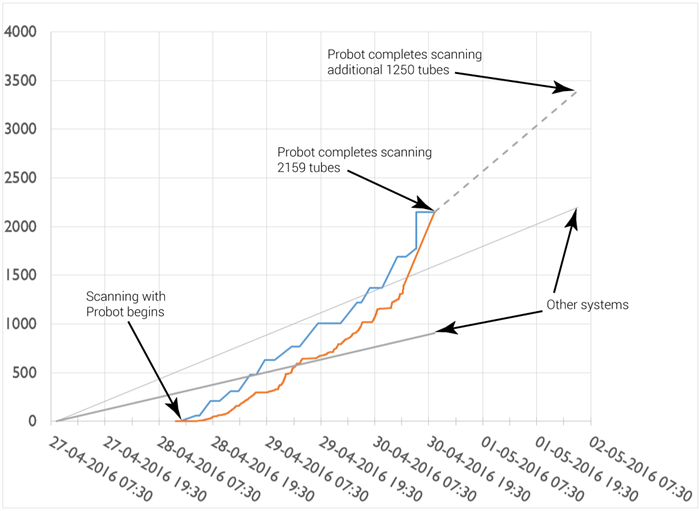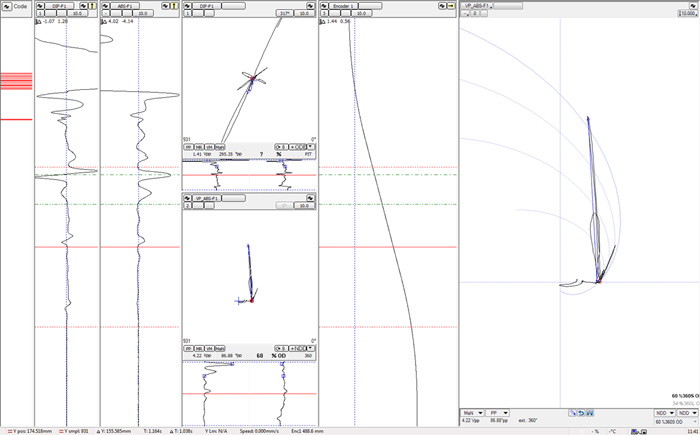High-speed Remote-field Testing in Carbon Steel Tubing with Probot
Carbon steel tubing is present in all industries. The comparative high-strength, crack-resistance, and low-cost of carbon steel tubing makes it the most prevalent type of pipe and tubing material worldwide.
The Challenge
Perform the high-speed RFT inspection of carbon steel tubes in nuclear power plant heat exchangers at current protocol quality.
Carbon steel tubing is typically inspected using an Internal Rotating Inspection System (IRIS) or Remote-Field Testing (RFT). Neither technique is noted for its impressive speed. A US nuclear utility challenged Eddyfi Technologies to deliver an RFT inspection system that could reduce the total time necessary to inspect a heat exchanger containing more than 2000 carbon steel tubes. The established inspection routine used RFT at 203 mm/s (8 in/s).
Mock-up studies, performed at the Electric Power Research Institute (EPRI) NDE center in Charlotte, North Carolina, established RFT could be used on SA-179 carbon steel tube specimens 19.00 mm in Outer Diameter (OD) and 1.24 mm in wall thickness (0.750 in OD, 0.049 in wall thickness) at up to 508 mm/s (20 in/s) without discernible signal attenuation or degradation.
The application required demonstrating whether this speed was sustainable under field conditions. Specifically, seeing how the higher inspection speed would impact probe life and signal quality. System integration would also be evaluated to determine whether it met inspection protocols.
Finally, systems would have to use downsized RFT probes to go through repair sleeves on the heat exchanger tubes. Four, vertical heat exchangers, with an inspection scope of approximately 2100 tubes were scheduled for inspection over 10 work shifts.
The Solution
A combination of high-performance test instrument, probe pusher, innovative acquisition software, and rugged probes.
To meet this challenge, a solution composed of the Ectane® 2 tester, Probot™ probe pusher, RFT probes, and the Magnifi® acquisition and analysis software.
Ectane 2 Test Equipment
Eddyfi Technologies' workhorse tester. It’s portable, battery-powered, and supports a wide selection of inspection technologies.
Probot Probe Pusher/Puller
Powerful, small-footprint probe pusher system designed to exceed the requirements of balance of plant inspections, while offering other markets a great productivity-enhancing tool. Probot is key to this solution, allowing it to reach the target 508 mm/s (20 in/s).
RFT Probes
The double-driver RFT probes are designed for differential and voltage-plane absolute signal analysis. This combination can detect corrosion, erosion, wear, and pitting (free span and adjacent to tubesheets and structures).
Magnifi
Finally, Magnifi is advanced acquisition and analysis desktop software. It uses a standard impedance plane and absolute voltage plane in RFT inspections. The impedance plane has proven an efficient tool to detect and characterize small volumetric defects with standard methods. The absolute voltage plane, on the other hand, enables a more precise characterization of large volumetric defects. Using both planes in concert allows improved detection, sizing, and defect characterization.
Magnifi is also capable of saving the balanced, nominal operating point. It becomes a reference that enables tubeto-tube permeability variation tracking and facilitates the normalization process.
Inspection Progress Report
Legacy RFT inspection systems were installed into three of the four heat exchangers to be inspected (one integrated instrument /probe drive and two stand-alone probe drives). The Eddyfi Technologies solution was installed into the remaining heat exchanger.
The Eddyfi Technologies system performed a total of 2159 straight-leg scans over approximately five shifts. The first probe, still being in good working condition, was replaced with a new probe and an additional 1250 straight-leg scans were completed in one of the other heat exchangers.
Data analysis and management personnel kept pace despite the higher acquisition speed and a brief training period on the software and analysis method (RFT absolute voltage plane).

RFT Inspection Results
The Probot probe pusher, Ectane 2 test instrument, RFT probes, and Magnifi software were deployed to inspect a large carbon steel heat exchanger, demonstrating:
- Significantly higher acquisition rates in carbon steel tubing
- Excellent data quality
- No increased probe wear
- No significant disruption of the normal inspection workflow

Benefits
- Faster inspections, high-quality, easy-to-analyze RFT data.
The solution offers a number of benefits:
Speed
RFT inspections 2.5 times faster than the current inspection methods.
High-quality data
Despite the higher inspection speed, acquired data shows no significant signs of attenuation or deterioration compared to historical data.
Durability
The stainless steel sleeve of the RFT probe made it capable of inspecting well over 2000 tubes.
Better defect characterization
One-click normalization of all channels, automatically generated sizing curves, and normalization tracking enable easier, faster, and more precise characterization of volumetric defects.
Easy deployment
The entire solution is portable, light, compact and fast to deploy for improved productivity.
The results speak for themselves. Eddyfi Technologies can greatly improve acquisition speed without compromising data quality in this challenging application.








